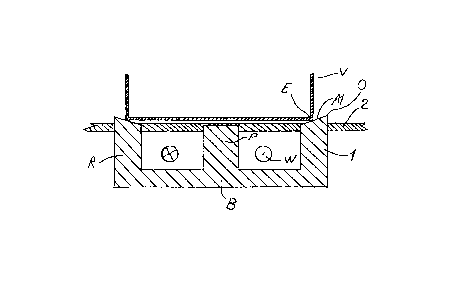Some of the information on this Web page has been provided by external sources. The Government of Canada is not responsible for the accuracy, reliability or currency of the information supplied by external sources. Users wishing to rely upon this information should consult directly with the source of the information. Content provided by external sources is not subject to official languages, privacy and accessibility requirements.
Any discrepancies in the text and image of the Claims and Abstract are due to differing posting times. Text of the Claims and Abstract are posted:
| (12) Patent Application: | (11) CA 2283125 |
|---|---|
| (54) English Title: | A CORE STRUCTURE FOR AN INDUCTION HEATING ELEMENT |
| (54) French Title: | STRUCTURE DE NOYAU POUR ELEMENT DE CHAUFFAGE PAR INDUCTION |
| Status: | Deemed Abandoned and Beyond the Period of Reinstatement - Pending Response to Notice of Disregarded Communication |
| (51) International Patent Classification (IPC): |
|
|---|---|
| (72) Inventors : |
|
| (73) Owners : |
|
| (71) Applicants : |
|
| (74) Agent: | SMART & BIGGAR LP |
| (74) Associate agent: | |
| (45) Issued: | |
| (86) PCT Filing Date: | 1998-03-13 |
| (87) Open to Public Inspection: | 1998-09-17 |
| Availability of licence: | N/A |
| Dedicated to the Public: | N/A |
| (25) Language of filing: | English |
| Patent Cooperation Treaty (PCT): | Yes |
|---|---|
| (86) PCT Filing Number: | PCT/DK1998/000096 |
| (87) International Publication Number: | WO 1998041061 |
| (85) National Entry: | 1999-09-01 |
| (30) Application Priority Data: | ||||||
|---|---|---|---|---|---|---|
|
A dish-shaped core for an induction heating apparatus is provided with rim
parts which present a large area to the edge of the cooking vessel. These rim
parts are obtained by means of a slanted cut of the rim or by slanting the rim
itself inwards. The leakage flux is reduced because the edge of the cooking
vessel acts as an "attractor" for the flux lines emanating from the core.
Un noyau de forme évasée destiné à un appareil de chauffage par induction comprend des parties de couronne présentant une grande surface jusqu'au bord du récipient de cuisson. Ces parties de couronne sont obtenues au moyen d'une découpe oblique de la couronne ou par découpe oblique de la couronne elle-même vers l'intérieur. Le flux de fuite est réduit du fait que le bord du récipient de cuisson fait office d'"attracteur" pour les lignes de flux émanant du noyau.
Note: Claims are shown in the official language in which they were submitted.
Note: Descriptions are shown in the official language in which they were submitted.

2024-08-01:As part of the Next Generation Patents (NGP) transition, the Canadian Patents Database (CPD) now contains a more detailed Event History, which replicates the Event Log of our new back-office solution.
Please note that "Inactive:" events refers to events no longer in use in our new back-office solution.
For a clearer understanding of the status of the application/patent presented on this page, the site Disclaimer , as well as the definitions for Patent , Event History , Maintenance Fee and Payment History should be consulted.
| Description | Date |
|---|---|
| Time Limit for Reversal Expired | 2004-03-15 |
| Application Not Reinstated by Deadline | 2004-03-15 |
| Inactive: Abandon-RFE+Late fee unpaid-Correspondence sent | 2003-03-13 |
| Deemed Abandoned - Failure to Respond to Maintenance Fee Notice | 2003-03-13 |
| Letter Sent | 2001-03-23 |
| Reinstatement Requirements Deemed Compliant for All Abandonment Reasons | 2001-03-15 |
| Deemed Abandoned - Failure to Respond to Maintenance Fee Notice | 2001-03-13 |
| Letter Sent | 2000-02-25 |
| Inactive: Single transfer | 2000-01-28 |
| Inactive: Cover page published | 1999-11-05 |
| Inactive: First IPC assigned | 1999-10-29 |
| Inactive: Courtesy letter - Evidence | 1999-10-19 |
| Inactive: Notice - National entry - No RFE | 1999-10-13 |
| Application Received - PCT | 1999-10-08 |
| Application Published (Open to Public Inspection) | 1998-09-17 |
| Abandonment Date | Reason | Reinstatement Date |
|---|---|---|
| 2003-03-13 | ||
| 2001-03-13 |
The last payment was received on 2002-03-13
Note : If the full payment has not been received on or before the date indicated, a further fee may be required which may be one of the following
Please refer to the CIPO Patent Fees web page to see all current fee amounts.
| Fee Type | Anniversary Year | Due Date | Paid Date |
|---|---|---|---|
| Basic national fee - standard | 1999-09-01 | ||
| Registration of a document | 2000-01-28 | ||
| MF (application, 2nd anniv.) - standard | 02 | 2000-03-13 | 2000-03-06 |
| MF (application, 3rd anniv.) - standard | 03 | 2001-03-13 | 2001-03-15 |
| Reinstatement | 2001-03-15 | ||
| MF (application, 4th anniv.) - standard | 04 | 2002-03-13 | 2002-03-13 |
Note: Records showing the ownership history in alphabetical order.
| Current Owners on Record |
|---|
| AKTIEBOLAGET ELECTROLUX |
| Past Owners on Record |
|---|
| CHRISTIAN ESKILDSEN |